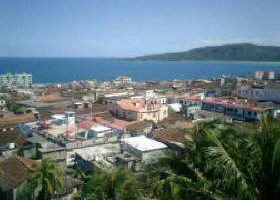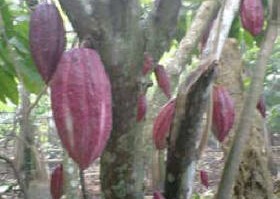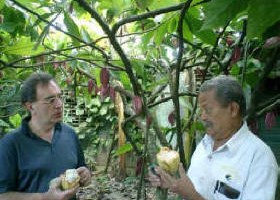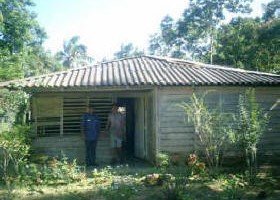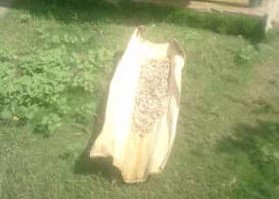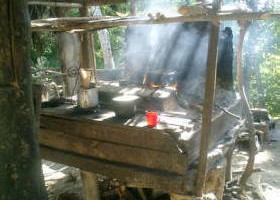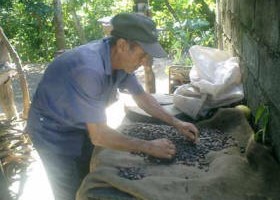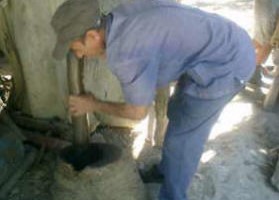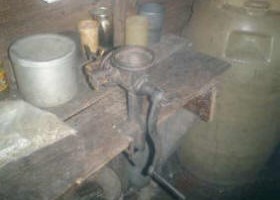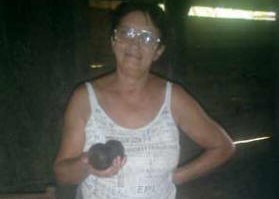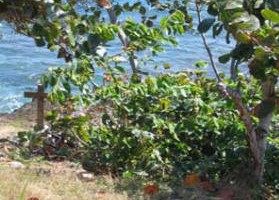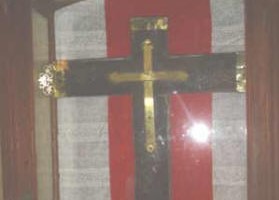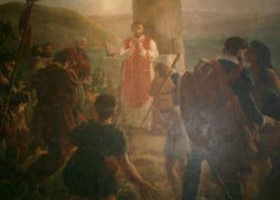Cultivating Cocoa in Cuba
It's still not known what date cocoa was introduced to Cuba.
Some say cocoa would have been brought to Cuba from Mexico around 1540 by the Spanish. Others believe it would have been imported by the French later on.
But the first real proof of the presence of cocoa in Cuba dates from 1748.
At the beginning of the 1800s there was large scale exportation of cocoa and coffee.
There's no long, native tradition of consuming cocoa beans in the form of a divine or fortifying drink, as there was, for example, in Mexico.
So the cocoa tree had been introduced to be cultivated and didn't grow in the wild.
The only region where cultivation continues today is in Baracoa, in the south eastern tip of the island.
Several pockets of cultivation exist elsewhere in the country, but they're negligible.
he small farmers work small areas, often on slopes where they harvest the cocoa pods during two periods. The biggest harvest is from February to July. A second, smaller harvest is from September to December.
These smallholders deliver the beans, freshly removed from the pods, to a drying plant which then sells them on to a factory which produces mass, butter and powdered forms of cocoa and chocolate from Baracoa.
These families lead a precarious existence, with a poorly paid, hardworking life.
The welcome they extend to visitors bears no relation to their means.
They give a hugely warm welcome to guests and share what little they have with them.
While the husband gives you an explanation of his work, the wife prepares an excellent cup of coffee. And you can be sure that you'll leave laden down with freshly picked fruit and balls of "peten" or ground cocoa beans.
The preparation is as follows:
Having picked ripe pods, the beans are put to ferment under banana leaves for 5 or 6 days. Then they are dried in the sun on a specially built platform near to the hut.
This is generally made up of three rooms. There's a sort of living room with a table, chairs and sometimes one or two armchairs, a bedroom and a cooking area which is partly open-air with a fire.
The fermented, dried grains are toasted on this fire in a casserole dish.
Once cooled, the husks are removed and the beans are ground either using a "pestle and mortar" carved from a tree trunk or a metal mill.
The resulting paste is mixed with a little flour to make balls called "bolas de peten".
To use them, these balls are grated and the powder produced is diluted in water or warmed milk (if you have any, as they said), sugar is added and, depending on personal recipes, cinnamon, cloves, vanilla and nutmeg.
The visit to Baracoa and its cocoa growers is a humbling experience of a way of life which really makes you stop and think. It has left us with a lifelong impression and a strong desire to return to relive what was a wonderful experience and to re-visit the people who welcomed us so warmly.
Christopher Columbus landed in Cuba on October 28th, 1492 in the Bariay bay in the Holguin province.
The spot in the region of Baracoa where he landed on November 28th of the same year in Baracoa is marked with a cross.
Christopher Columbus was accompanied by priests who wanted to bring Christianity to the countries they journeyed through.
To mark their visit, they planted crosses. One of them, indeed the only one to have survived until today is to be found in the church at Baracoa.
This cross, called " la Cruz de la Parra ", has been carbon dated. The analysis has proved that the wood does in fact date from the 15th century. It is therefore plausible that this is indeed one of the 29 crosses planted by Christopher Columbus on his voyages in the Americas.
Bartolomé de las Casas used it to say Mass when he visited Baracoa subsequently.
Today the la Cruz de la Parra has been placed in a shrine and its extremities are encased in metal to stop the faithful taking away a splinter of wood as an amulet or a souvenir.
History of cocoa and chocolate in CubaIt is not easy to reconstitute the history of cocoa in Cuba and its use during the two centuries immediately following the Spanish conquests,
because its agricultural and economic importance faded during this period.
It is however almost certain that the cocoa tree did not exist during colonial times.
It was introduced during the first part of the 16th century, coming from Mexico probably around 1540.
Cultivation of cocoa remained small however and it was only grown for family consumption.
It was only around 1760 that a major effort was made to diversify Cuban agriculture based on sugar and tobacco.
Cultivating cocoa and coffee developed a little, mainly under the influence of French people coming from Haiti.
The consumption of cocoa as a chocolate drink was, however, quite widespread.
During the 19th century, coffee gradually took over and became the island's national drink.
Production of cocoa in the island remained very limited and it was usually grown by families for their own consumption.
Moreover, most of the trees were destroyed during the struggle for independence in the early 1900s.
The only place where there is still a little cocoa production today it is in the extreme east of the country, in the Baracoa region.
All the cocoa producing families together only produce between two and 3000 tons of beans.
This is an interesting recipe for making good chocolate which comes from Cuba
FRENCH DOMINICAN CUISINE AT UNIVERSITY AND CHOCOLATE
Professeur Dr. Delio Carreras Cuevas
Because the order was founded right in the middle of the religious struggle against the "ALBIGEOIS" heretics in France, the culinary tradition of the PERES PREDICATEURS, known in the vernacular as PERES DOMINICAINS or Dominican fathers, and later the MERES DOMINICAINES - Dominican mothers -, joined in the festivities on October 7th for NOTRE DAME DU ROSAIRE, the main Dominican devotion. The cleverest and most expert hands were dedicated to making exquisite masterpieces called GÂTEAUX made with chocolate.
Independent of the fact that many "RECIPES" are written in french, in the "LIBRO MAYOR, ATRAMENTARIUM, ET CULINARIUM" at the old convent of Santo Domingo home of the Pontifical and Royal University of Saint Jerome of Havana, since its foundation on January 5th 1728 and going under the curious name "LOUANGES DE SANTO DOMINGO", this is an approximate transcription of the recipe.
Notice from the MOTHER SUPERIOR "CHOCOLATIERE"
a) Carefully select the chocolate powder to be used according to its texture, aroma and quality, its provenance and its taste, its purity and its confirmation.
b) Carefully check the cleanliness,of cauldrons and pans
c) Light the fire with a vibrant flame and use dry wood from trees that were robust. Cooking is the task of BROTHER FIRE as it is said to have been called by Saint Francis of Assisi
d) Check the freshness and state of emulsion of the butter to be used, which should, preferably, be made on the day itself with boiled, fresh milk and infinite patience, as taught to us by the sacred devotion of Christ of patience.
e) Pass flour from Castille (and only from Castille) through a fine sieve. According to the gospels, it is the small things which have the greatest value in the eyes of the Lord (THE BEATITUDES OF THE SERMON ON THE MOUNT)
f) Take great care in mixing the chocolate paste, a mixture of great value, in order that it does not harden ; not too hot that it burns, neither so cold that it sets. According to the ACTS OF THE APOSTLES ( neither hot nor cold shall I vomit you from my mouth)
g) Only on the day of the sacred SAINT JOHN OF GOD, on March 8th, and by the grace of the FATHERS OF THE HOSPITALIER ORDER OF SAINT JOHN OF GOD, will it be permitted to add a little Cuban rum as a flavouring to this sacrosanct delicacy,
DE PHARMA E VADEMECUM
Recipe :
alfa) Heat and melt the butter in a small cauldron and add some island sugar, stirring energetically until the mixture swells like a blister (identical to the painful blisters and wounds of the Saviour on THE WAY OF THE CROSS.)
Beta) Break 8 eggs gently, like chicks breaking their shell and add them to 400 grams of butter and 400 grams of sugar, by mixing them with a force like the flagellation of Christ in the temple of the Jews
Gamma) With a wooden spatula, add four spoonfuls of Castille flour, well sieved so that, as the gospel teaches us, new wine is not poured into old.
Delta) Melt the chocolate as slowly as Saint Maur in torment in a small bronze cauldron, and before it sets, add it to the preparation described above, like Jesus throwing himself against the DEMON OF CESARA
Epsilon) Add a little vanilla lightened by local honey and beat until the mixture is compact as if for transmutation, by mixing the spiritual and the temporal.
Kappa) Cover the interior of a copper pot with a little butter and pour in the mixture, keep it on a slow fire for 20 minutes of a canonical hour, preferring the morning for this operation, the senses being more awake at this time of day.
Lambda) Once you have verified that there is no more noise and that the mixture has achieved a certain rigidity (from which our Lord Jesus Christ escaped at his assumption), cut it into small rectangles, a geometrical shape which adjusts best to the poetry of our sacred order inspired by gourmandize.
...No pleniary or partial indulgence will be required , and no excommunication dictated for parsimonious enjoyment of this delicacy and it will be for a greater glory, health and excitation made with the bush they call CACAO and from which our SISTER EARTH as the Seraphic father Saint Francis says in his CANTICLE OF THE CREATURES CHOCOLATE does us good.
